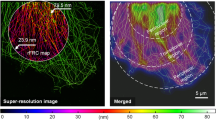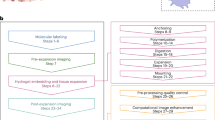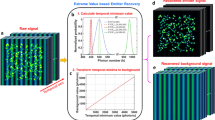Abstract
Super-resolution microscopy depends on steps that can contribute to the formation of image artifacts, leading to misinterpretation of biological information. We present NanoJ-SQUIRREL, an ImageJ-based analytical approach that provides quantitative assessment of super-resolution image quality. By comparing diffraction-limited images and super-resolution equivalents of the same acquisition volume, this approach generates a quantitative map of super-resolution defects and can guide researchers in optimizing imaging parameters.
This is a preview of subscription content, access via your institution
Access options
Access Nature and 54 other Nature Portfolio journals
Get Nature+, our best-value online-access subscription
$32.99 / 30 days
cancel any time
Subscribe to this journal
Receive 12 print issues and online access
$259.00 per year
only $21.58 per issue
Buy this article
- Purchase on SpringerLink
- Instant access to full article PDF
Prices may be subject to local taxes which are calculated during checkout



Similar content being viewed by others
Change history
19 October 2020
An amendment to this paper has been published and can be accessed via a link at the top of the paper.
References
Dempsey, G.T., Vaughan, J.C., Chen, K.H., Bates, M. & Zhuang, X. Nat. Methods 8, 1027–1036 (2011).
Almada, P., Culley, S. & Henriques, R. Methods 88, 109–121 (2015).
Pereira, P.M., Almada, P. & Henriques, R. Methods Cell Biol. 125, 95–117 (2015).
van de Linde, S. et al. Nat. Protoc. 6, 991–1009 (2011).
Sage, D. et al. Nat. Methods 12, 717–724 (2015).
Pengo, T., Olivier, N. & Manley, S. Preprint at https://arxiv.org/abs/1501.05807 (2015).
Fox-Roberts, P. et al. Nat. Commun. 8, 13558 (2017).
Betzig, E. et al. Science 313, 1642–1645 (2006).
Gustafsson, M.G. J. Microsc. 198, 82–87 (2000).
Ball, G. et al. Sci. Rep. 5, 15915 (2015).
Förster, R., Wicker, K., Müller, W., Jost, A. & Heintzmann, R. Opt. Express 24, 22121–22134 (2016).
Schindelin, J. et al. Nat. Methods 9, 676–682 (2012).
Venkataramani, V., Herrmannsdörfer, F., Heilemann, M. & Kuner, T. Nat. Methods 13, 319–321 (2016).
Gustafsson, N. et al. Nat. Commun. 7, 12471 (2016).
Cyrklaff, M. et al. Proc. Natl. Acad. Sci. USA 102, 2772–2777 (2005).
Nieuwenhuizen, R.P.J. et al. Nat. Methods 10, 557–562 (2013).
Ovesný, M., Křížek, P., Borkovec, J., Švindrych, Z. & Hagen, G.M. Bioinformatics 30, 2389–2390 (2014).
Henriques, R. et al. Nat. Methods 7, 339–340 (2010).
Müller, M., Mönkemöller, V., Hennig, S., Hübner, W. & Huser, T. Nat. Commun. 7, 10980 (2016).
Kirshner, H., Aquet, F., Sage, D. & Unser, M. J. Microsc. 249, 13–25 (2013).
Schmidt, F.I. et al. Cell Rep. 4, 464–476 (2013).
Albrecht, D. et al. J. Cell Biol. 215, 37 (2016).
Jungmann, R. et al. Nat. Methods 11, 313–318 (2014).
Ganguly, A. et al. J. Cell Biol. 210, 401–417 (2015).
Geissbuehler, S., Dellagiacoma, C. & Lasser, T. Biomed. Opt. Express 2, 408–420 (2011).
Acknowledgements
We thank A. Knight (Holistx Ltd.) and S. Holden (Newcastle University) for critical reading of the manuscript; J. Ries (European Laboratory for Molecular Biology, Heidelberg) for provision of customized MATLAB software and critical reading of the manuscript; K. Tosheva (University College London) for critical reading of the manuscript and beta testing of the software; and B. Baum (University College London) for reagents. Many of the look-up tables used here are based on the open-source repository of D. Williamson at King′s College London. This work was funded by grants from the UK Biotechnology and Biological Sciences Research Council (BB/M022374/1; BB/P027431/1; BB/R000697/1) (R.H. and P.M.P.), MRC Programme Grant (MC_UU12018/7) (J.M.), the European Research Council (649101–UbiProPox) (J.M.), the UK Medical Research Council (MR/K015826/1) (R.H. and J.M.), the Wellcome Trust (203276/Z/16/Z) (S.C. and R.H.) and the Centre National de la Recherche Scientifique (CNRS ATIP-AVENIR program AO2016) (C.L.). D.A. is presently a Marie Curie fellow (Marie Sklodowska-Curie grant agreement No 750673). C.J. funded by a Commonwealth scholarship, funded by the UK government.
Author information
Authors and Affiliations
Contributions
S.C. and R.H. devised the conceptual framework and derived theoretical results. S.C., D.A., C.L., J.M., and R.H. planned experiments. S.C. and R.H. wrote the algorithm. Simulations were done by S.C. Experimental data sets were acquired by S.C. (Fig. 1), D.A. (Fig. 2; Supplementary Notes 4 and 7), C.J. (Fig. 2 and Supplementary Note 9), P.M.P. (Fig. 3), and C.L. (Supplementary Notes 5, 10, and 11). Data were analyzed by S.C. and D.A.; and C.L., J.M., and R.H. provided research advice. The paper was written by S.C., D.A., J.M., and R.H. with editing contributions from all the authors.
Corresponding authors
Ethics declarations
Competing interests
The authors declare no competing financial interests.
Supplementary information
Supplementary Text and Figures
Supplementary Notes 1–11 (PDF 32445 kb)
Supplementary Software
Binaries, source code and user manual for NanoJ-SQUIRREL (ZIP 13406 kb)
Rights and permissions
About this article
Cite this article
Culley, S., Albrecht, D., Jacobs, C. et al. Quantitative mapping and minimization of super-resolution optical imaging artifacts. Nat Methods 15, 263–266 (2018). https://doi.org/10.1038/nmeth.4605
Received:
Accepted:
Published:
Issue date:
DOI: https://doi.org/10.1038/nmeth.4605
This article is cited by
-
Efficiently accelerated bioimage analysis with NanoPyx, a Liquid Engine-powered Python framework
Nature Methods (2025)
-
High-fidelity tissue super-resolution imaging achieved with confocal2 spinning-disk image scanning microscopy
Light: Science & Applications (2025)
-
Expansion and fluctuations-enhanced microscopy for nanoscale molecular profiling of cells and tissues
Nature Protocols (2025)
-
Real-time nanoscale investigation of spore coat assembly in Bacillus subtilis
Communications Biology (2025)
-
Adaptive-learning physics-assisted light-field microscopy enables day-long and millisecond-scale super-resolution imaging of 3D subcellular dynamics
Nature Communications (2025)



